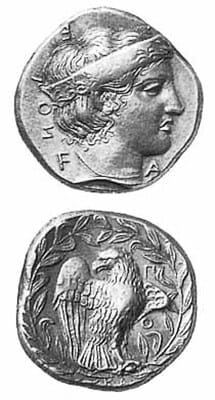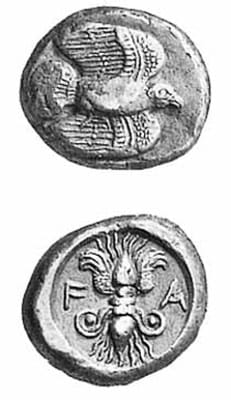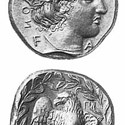This is exactly what Leu (Zurich) (15% buyer's premium plus local sales tax) held on May 10 when they dispersed the BCD collection - and that is exactly what happened.
So comprehensive is this 345-lot catalogue, with its detailed introductions and bibliography, that it must now be considered a standard work.
The first coin of Olympia coincided with the 78th Olympiad in 468BC. It has a splendid flying eagle and a massive threatening thunderbolt. An estimate of SFr15,000 was suggested, but it made SFr25,000 (£10,870).
This coin is no stranger to the London scene. It was sold at Glendinings in December 1986 for £16,000 (estimate £2500-3000). This leads me to suspect that Greek coins are currently rather inexpensive if you buy skilfully, a view which is supported by the firmness of the market for English coins and which is reflected on the continent.
Before reporting something more affordable, you should know that the highest price of the day was achieved by the equally artistic silver stater by the die-cutter Polykaon (he signed the die) and struck for the 100th Olympiad. The estimate was SFr55,000, but it made SFr164,000 (£71,300). This coin too is no stranger. It was sold in the celebrated Kunstfreund sale in Zurich back in 1974 for SFr91,000, which was then £12,130. Of course, the investment perspective depends on which currency is significant to you.
Not all Greek coins have to be mega-money. The smaller version of the first coin reported here, but with the same images, was estimated at SFr750 (£325), and it made just that.
The total for this sale was SFr1.61m (£700,000).
It is a relief to report that there are still many elegant Greek coins, mainly from the mints of Sicily and Southern Italy, which would be a credit to any intelligent collection, in the lower three figures - and I mean sterling three figures.
£1 = SFr2.3
Playing the Games and winning
AN auction of the most comprehensive collection of the ancient coins of Olympia in the year that Athens hosts the modern Olympic Games is likely to meet with very considerable success.








